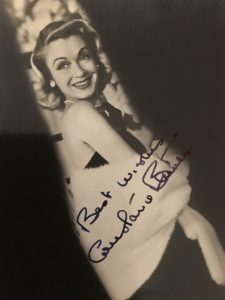
Constance Bennett (Wikipedia)
Constance Bennett was an American stage, film, radio and television actress. She was a major Hollywood star during the 1920s and 1930s and for a time during the early 1930s, she was the highest-paid actress in Hollywood, as well as one of the most popular. Bennett frequently played society women, focusing on melodramas in the early 1930s and then taking more comedic roles in the late 1930s and 1940s. She is best known today for her leading roles in What Price Hollywood? (1932), Bed of Roses (1933), Topper (1937), Topper Takes a Trip (1938), and had a prominent supporting role in Greta Garbo‘s last film, Two-Faced Woman (1941).
She was the daughter of stage and silent film star Richard Bennett, and the older sister of actress Joan Bennett.
Constance Bennett was born in New York City, the eldest of three daughters of actress Adrienne Morrison and actor Richard Bennett. Her younger sisters were actresses Joan Bennett and Barbara Bennett. All three girls attended the Chapin School in New York.
After some time spent in a convent, Bennett went into the family business. Independent, cultured, ironic and outspoken, Constance, the first Bennett sister to enter motion pictures, appeared in New York-produced silent movies before a meeting with Samuel Goldwyn led to her Hollywood debut in Cytherea (1924). She abandoned a burgeoning career in silents for marriage to Philip Plant in 1925, but resumed her film career after their divorce, with the advent of talking pictures (1929), and with her delicate blonde features and glamorous fashion style, she quickly became a popular film star.
In the early 1930s, Bennett was frequently among the top actresses named in audience popularity and box-office polls. For a short time, she was the highest-paid actress in Hollywood. So successful was Bennett during this time, that RKO, Bennett’s home studio at the time, controlled the careers of actresses Ann Harding and Helen Twelvetrees in a similar manner, hoping to duplicate Bennett’s success.
In 1931, a short-lived contract with Metro-Goldwyn-Mayer earned her $300,000 for two movies which included The Easiest Way and made her one of the highest-paid stars in Hollywood. Warner Brothers paid her the all-time high salary of $30,000 a week for Bought! in 1931.[4] Richard Bennett, her father, was also cast in this film.
The next year she moved to RKO, where she acted in What Price Hollywood? (1932), directed by George Cukor, an ironic and at the same time tragic behind-the-scenes looks at the old Hollywood studio system, in which she portrayed waitress Mary Evans, who becomes a movie star. Lowell Sherman co-starred as the film director who discovers her, and Neil Hamilton as the wealthy playboy she marries. It was a critical and box office hit at the time of its release. The film Morning Glory had been written with Bennett in mind for the lead role, but producer Pandro S. Berman gave the role to Katharine Hepburn, who won an Academy Award for her performance.
Bennett next showed her versatility in the likes of Our Betters (1933), writer/director Gregory La Cava‘s Bed of Roses (1933) with Pert Kelton, After Tonight (1933) (co-starring with future husband Gilbert Roland), The Affairs of Cellini (1934), After Office Hours (1935) with Clark Gable, the original Topper (1937, in a career standout as Marian Kerby opposite Cary Grant, a role she repeated in the 1939 sequel, Topper Takes a Trip), the ultimate madcap family comedy Merrily We Live (1938) and Two-Faced Woman (1941, supporting Greta Garbo).
By the 1940s, Bennett was working less frequently in film but was in demand in both radio and theatre. She had her own program, Constance Bennett Calls on You, on ABC radio in 1945-1946. Shrewd investments had made her a wealthy woman, and she founded a cosmetics and clothing company.


